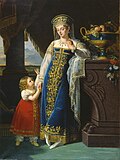Robert Lefèvre

Robert Jacques François Faust Lefèvre (French pronunciation: [ʁɔbɛʁ ʒak fʁɑ̃swa fɔst ləfɛvʁ], 24 September 1755, in Bayeux – 3 October 1830, in Paris) was a French painter of portraits, history paintings and religious paintings. He was heavily influenced by Jacques-Louis David and his style is reminiscent of the antique.
Life
[edit]

Robert Lefèvre made his first drawings on the papers of a procureur to whom his father had apprenticed him. With his parents' consent, he abandoned this apprenticeship and walked from Caen to Paris to become a student of Jean-Baptiste Regnault (in whose studio he met and became friends with Charles Paul Landon). At the 1791 Paris Salon he exhibited his Dame en velours noir, the point of departure for his reputation. In 1805, Lefèvre painted the portrait of Empress Joséphine, and in 1807 a matching portrait of Napoléon was painted by Louis-André-Gabriel Bouchet. Napoléon gave both paintings to the city of Aachen in 1807, where they are today in the city hall and decorate the entrance hall.
His other portraits of Napoleon,[1] Joséphine, Madame Laetitia, Guérin, Carle Vernet (a portrait which is now at the Louvre) and pope Pius VII made him a fashionable portrait artist and one of the main portraitists of the imperial personalities, a reputation sealed by his portrait of Napoleon's new wife Marie Louise.
On the Bourbon Restoration Robert Lefèvre painted a portrait of Louis XVIII for the Chambre des Pairs and received the cross of the Légion d'honneur and the title of First Painter to the King, losing the latter on the July Revolution. He painted a large number of portraits and history paintings. The main example of his portraits are those of Malherbe (Bibliothèque publique de Caen), Charles X, the duchesse d’Angoulême, the duchesse de Berry, Charles-Pierre-François Augereau duc de Castiglione (Musée de Versailles), and of Dominique Vivant Denon. Two of his mythological paintings - Love sharpening his arrows and Love disarmed by Venus (t. 1,84 sur 1,30 [2]), were engraved by Desnoyers - the latter is reproduced in le Nu Ancien et Moderne. His most notable history paintings are his Phocion getting ready to drink hemlock, Roger delivering Angélique, Héloïse and Abelard and a Crucifixion for the Mont Valérien. His last painting was The Apotheosis of Saint Louis for the Cathedral of La Rochelle.
While he was working on this last painting, the Revolution of July 1830 took place, an event which was to deprive him of his support and official posts. Ill, depressed and desperate, he committed suicide by cutting his throat at his house on the night of 2/3 October 1830; he was 75 years old. He was buried in the Père Lachaise Cemetery, in Paris.[3]
Gallery
[edit]-
Cupid sharpening his arrows (1798)
-
Princess Pauline Borghese (1806)
-
Portrait of the Duchess of Berry (1826)
-
Maria Baryatinskaya (1819)
-
M.F. Baryatinskaya with daughter Olga (1817)
-
Portrait of Napoleon in Coronation Robes (1811)
References
[edit]- Gaston Lavalley, Le Peintre Robert Lefèvre, sa vie et son œuvre, Caen, L. Jouan, [s.d.], (c 1920).
- Mémoires de la Société des sciences, arts et Belles-Lettres de Bayeux, 1901, p. 121-2
Notes
[edit]- ^ "Sale of the century as aristocrats auction heirlooms". Daily Telegraph.
- ^ According to the Catalogue sommaire illustré des peintures du musée du Louvre et du musée d'Orsay, volume V, appendices and index, established by Isabelle Compin & Anne Roquebert, Liste des tableaux déposés par le Louvre by Élisabetth-Foucart-Walter, Paris, 1986, page 291, n° d'inventaire INV 4418, this work was in 1872 placed in the musée de Varzy
- ^ "Fondation Napoléon". Napoleon.org. Retrieved 2013-07-07.
External links
[edit]- 1755 births
- 1830 deaths
- People from Bayeux
- Artists from Normandy
- 18th-century French painters
- French male painters
- 19th-century French painters
- Knights of the Legion of Honour
- Burials at Père Lachaise Cemetery
- Suicides by sharp instrument in France
- 19th-century French male artists
- 18th-century French male artists






